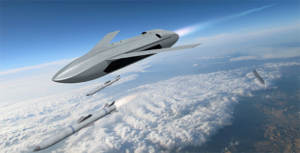The Pentagon is launching a new unmanned air vehicle (UAV) to engage opponents in air-to-air combat with the LongShot program.
On Feb. 8, the Defense Advanced Research Projects Agency (DARPA) announced it awarded contracts to General Atomics, Lockheed Martin [LMT], and Northrop Grumman [NOC] for preliminary Phase I design work for LongShot.

LongShot aims to develop an air-launched UAV that can use multiple air-to-air weapons. The overall objective “is to develop a novel UAV that can significantly extend engagement ranges, increase mission effectiveness, and reduce the risk to manned aircraft,” the agency said in a statement.
Whereas current air superiority focuses on manned fighter aircraft to provide penetrating counter air capability to deliver weapons, DARPA said it envisions LongShot will increase the survivability of traditional manned aircraft by letting them remain at standoff ranges farther away from threats. The LongShot would then move closer to take more effective missile shots.
“The LongShot program changes the paradigm of air combat operations by demonstrating an unmanned, air-launched vehicle capable of employing current and advanced air-to-air weapons,” DARPA program manager Lt. Col. Paul Calhoun, said in a statement.
“LongShot will disrupt traditional incremental weapon improvements by providing an alternative means of generating combat capability,” he added.
DARPA said in later phases, the program will construct and fly a full-scale air-launched demonstration system capable of controlled flight before, during, and after weapon ejection “under operational conditions.”
Then, on Feb. 12, DoD announced DARPA awarded General Atomics a $9 million control for LongShot Phase I to cover “the research, development, and demonstration of the Longshot.”
Work will largely occur in Poway, Calif.(71 percent), and Orlando, Fla. (14 percent), and is expected to be finished by February 2022.
At the time of award DoD obligated over $2 million in research and development funds.
The announcement noted this contract is a “limited sources competitive acquisition” in accordance with the original broad agency announcement.